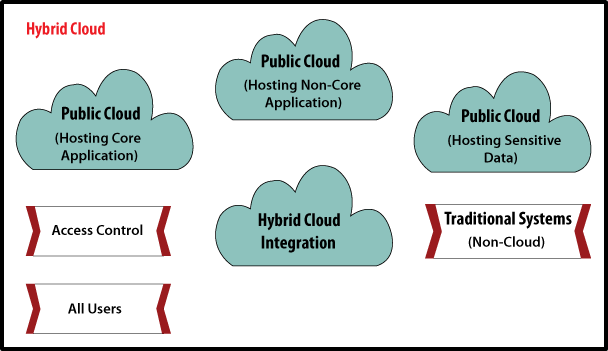Cloud computing is a key enabler for state-of-the-art service development for the banking and financial services industry. It allows them to tap into new service models for better customer service, improved productivity, cost-efficiency, and streamlined internal business processes.
Why Cloud Computing for the Banking and Financial Services Industry?
Banks can take advantage of Cloud solutions to serve customers better, and boost productivity and flexibility of internal business processes.
The technology also helps them find new opportunities for service delivery to customers, reduce costs and improve flexibility in conducting business. This way banks find a new way to stay relevant amidst a growing number of FinTech market entrants.
The report reveals that 54% of the organizations from the financial services and banking industry in the United States adopted Cloud workload in 2021.
Cloud computing enables financial institutions to have a straightway communication link to their customers. They can maintain customer relations remotely, and streamline various services, like storing, managing, and accessing the data for both the bankers and the customers.
Easy deployment and integration with all the services of the banking systems facilitated by Cloud computing allow decreased time and effort for the customers.
Banks can become more focused on prioritizing customer-centric delivery models and digitalization of the services to build a multi-channel relationship with the customers. They can transfer, update, and recover data trouble-free; thanks to the novelty of Cloud technology.
The banking and financial services industry can take advantage of Cloud computing in a number of ways, such as –
1. Easy Scalability and Agility
Nothing can downplay scalability while dealing with the practical aspects of systems and software. In the banks, the need for Cloud computing is dynamic. Meaning, the demand for utilizing computing resources is up and down based on the requirements.
Cloud computing helps banks scale their resources up or down, depending on the requirements. It enables them to free up the resources or deallocate them if not required.
Small and mid-size businesses could be the early adopters of Cloud computing to take advantage of scaling their resources efficiently (based on the requirements) without hampering operations.
It would also lay the groundwork for achieving infrastructure agility for the banks.
2. Reduced Costs
The cost of owning up the software infrastructure in the Cloud gets reduced significantly. Why? Well, shifting your legacy IT systems to a more productive Cloud-based environment lowers hardware equipment costs and reduces IT overheads for developing and maintaining servers.
Banks can leverage the technology to make their internal business processes systematic and more streamlined while adapting to organizational changes. The catch is, they don’t have to stall the ongoing operational procedures.
In terms of reducing costs, the benefit of Cloud implementation in banks also means that the user is billed according to the portion of the Cloud service used. It, therefore, allows financial institutions to use the part of the Cloud service essential for their business and pay for it.
To say otherwise, banks can avoid overutilization or under-utilization of the on-demand resource.
3. Better Process Efficiency
Adopting a Cloud-based model could pronounce an intelligent business decision based on how it delivers cost-efficiency and increased productivity. It simplifies various processes, including online payments, by connecting buyers and sellers on a single-dedicated Cloud platform.
Moreover, the technology enables bankers to utilize data analytics and conceive ideas about new products and services, resonating with customers’ expectations and market trends.
4. Faster Product Time to Market
Banks utilizing Cloud-based solutions avail broad network access and on-demand IT resources. It helps them cut the clutter in lead time and speed up implementing new ideas to make their products and services personalized and intuitive for customers.
5. Improved Security
One of the key upsides of adopting a Cloud computing model in the banking industry is the security. In fact, Cloud security is considered better and more robust than most on-premise systems. That’s because Cloud offers multiple layers of security measures against potential data breaches and cyber-attacks.
6. Easy Compliance with Regulations
When banks use Cloud platforms that comply with the financial industry regulations, it means they can ensure that the deployed IT assets on Cloud meet the regulatory compliance trouble-free.
Choosing The Right Cloud Model In The Financial Institutions
Financial institutions can rely on Cloud services adoption for trouble-free migration from the capital-intensive approach to a relatively more flexible business model that reduces the costs on internal business processes. However, what pans out successfully in Cloud services adoption is selecting the best Cloud service model commensurate with your business needs. Here is our rundown on some ideal Cloud Computing services, operation, and deployment models.
Cloud Deployment Models
1. Private Cloud

Considered the most secure Cloud infrastructure, private Cloud is offered to a single entity or company with multiple users (e.g. business units). Also called an internal Cloud, it gives you the latitude of taking control of IT operations, service integration, policies, and user behavior. It also supports legacy systems that can’t support the public Cloud and can be customized based on your needs.
2. Public Cloud

As the name itself suggests, this Cloud infrastructure is accessible to the general public and is owned by the company providing Cloud services.
A good example of Cloud hosting is Public Cloud. It allows customers to get services from Cloud service providers. Its storage backup and retrieval services are free, or based on subscription, or on a pay-user basis.
It requires minimal investment, no set-up cost, and maintenance. However, it lacks adequate security and customization features.
3. Hybrid Cloud

It is the constituent of two or more private or public Cloud architectures linked together to handle specific and priority-based business tasks. For instance, a bank can consider a private Cloud for storing critical data while a public Cloud to store non-sensitive data.
4. Community Cloud
This type of Cloud infrastructure service is ideal for a specific set of users with a common goal or objective and use cases. Relatively cheaper than public or private Cloud alternatives, the community Cloud offers great performance at relatively less investment.
The ownership, management, or the right to operate the Cloud infrastructure could rest on a single or more of the organizations and is deployable on or off-premise.
As far as banks are concerned regarding choosing the right Cloud model for their businesses, they prefer private and community Cloud deployment models.
Challenges In The Adoption Of Cloud Computing In Banks
Implementing Cloud Computing is not an easy task for banks. It’s so, as many financial institutions still rely on legacy IT systems to handle their internal business processes even in the age of digital innovations.
Here is our rundown on factors discouraging banks to adopt Cloud Computing in their business.
1. Concern Regarding Security Breach
With cybersecurity threats increasing at an alarming rate worldwide, banks can’t ignore the lingering security threats they would encounter during the Cloud-adoption journey.
It doesn’t mean that adopting a Cloud environment is unsafe for businesses. It depends on the Cloud service model you choose and the vendor’s reputation regarding the safety of its Cloud services.
Since banks have to deal with uncountable data volumes of customers and transactions, they can’t afford even a vestigial trace of data breach that would jeopardize confidential data stored in the Cloud.
2. Stringent Regulatory Compliances
Apart from dealing with growing competition and challenges, banks also have to deal with regulatory compliances from the government and environmental bodies.
For example, some regulations want banks not to intermix data with other data or keep the financial data of customers in their home country. This means it is essential for banks to have a clear idea of where their data resides in the Cloud.
Banks must ensure that they are choosing the right Cloud model suitable for their business needs without compromising on security aspects and regulatory compliances.
3. Lack of Standard Measures
Banks can never afford to compromise the quality of Cloud services and the security of the financial data of their customers. Unfortunately, there are no predefined metrics in place to measure performance and reliability of Cloud services provided by a vendor.
Besides, interoperability also is one of the factors dissuading banks from adopting Cloud. Interoperability refers to how different components or systems work together.
In the context of Cloud Computing, it means an easy migration experience for banks to a secure Cloud environment from their existing systems or moving from one vendor to another one, and vice versa.
Conclusion
Banking and financial service companies can take advantage of Cloud-hosted solutions. They can use it to improve their productivity & cost-efficiency, and streamline internal business processes excellently.
For years, Cloud Computing remains a mainstay technological enabler for cutting-edge service development, helping the banking sector to tap into futuristic Cloud service models to stay ahead of the curve.
Are you looking for futuristic software solutions to help you take advantage of Cloud Computing?
Choose Binmile is a trusted software development company for your quest. Get cutting-edge software solutions to streamline your banking processes. You will experience improved results in building customer loyalty, improving customer retention, and staying relevant in the competition.









